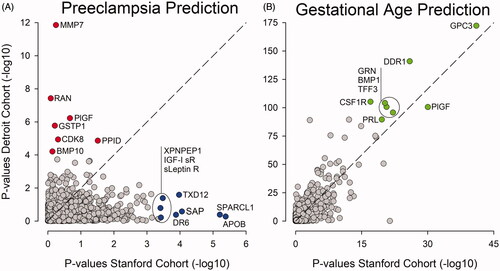Figures & data
Table 1. Patient and pregnancy data.
Figure 1. Highest-ranking proteins associated with PE differ between cohorts. (A) All 1116 proteins included in the analysis are plotted according to their respective p value when comparing women with PE to women with uncomplicated pregnancies in the Stanford (x-axis) and the Detroit (y-axis) cohorts. The highest-ranking proteins are not shared between the Stanford and the Detroit cohorts. (B) In contrast, the highest-ranking proteins predicting GA are shared between the Stanford and the Detroit cohorts . APOB: apolipoprotein; BMP1: bone morphogenetic protein 1; BMP10: bone morphogenetic protein 10; CDK8: cyclin-dependent kinase 8:cyclin-C complex; CSF1R: macrophage colony-stimulating factor 1 receptor; DDR1: discoidin domain receptor 1; DR6: tumor necrosis factor receptor superfamily member 21; GPC3: glypican-3; GRN: granulins; GSTP1: glutathione S-transferase P; IGI-I sR: insulin-like growth factor 1 receptor; sLeptin R: Leptin receptor; MMP7: matrilysin; PIGF: placenta growth factor; PPID: peptidyl-prolyl cis-trans isomerase D; PRL: prolactin; RAN: GTP-binding nuclear protein Ran; SAP: serum amyloid P-component; SPARCL: SPARC-like protein 1; TFF3: trefoil factor 3; TXD12: thioredoxin domain-containing protein 12; XPNPEP1: Xaa-Pro aminopeptidase 1.

